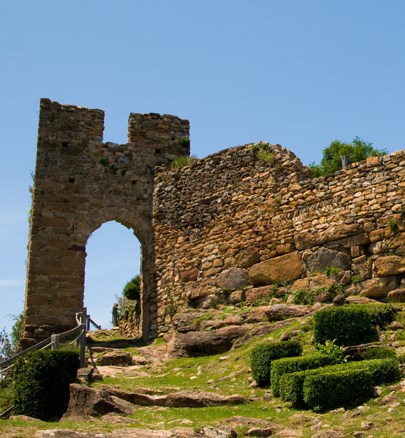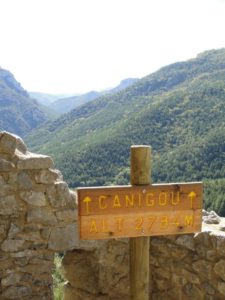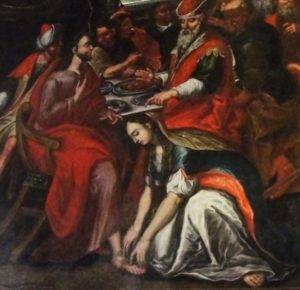Chateau Lordat and Visions of John
‘Magdalene and John the Virgin will tower over all my disciples and all men who shall receive the mysteries.’
Pistis Sophia codex
Finding the story in a place or an ancient site often requires probing beneath the surface. The process of sorting out the broken threads that history has left us calls for a visionary view. If one takes the time to listen, look, and sense, a pattern emerges. We can ‘dream’ the subtle energies and qualities that reside in a site and perhaps discover some of the gifts remaining that have been shrouded by time–an imprint waiting ‘for those with eyes to see and ears to hear’.
On my first visit to the Castle of Lordat in the French Pyrenees, I had a vision regarding what is sometimes called the ‘Holy Family’, including several of Jesus’ inner circle of disciples. I saw them traveling from Tasascon-sur-Rhone near Arles, France, to the city further west, also called Tarascon, on the great Ariege River in the Pyrenees. This river lies at the bottom of a steep and narrow valley with sheer mountain faces on either side, dotted with countless caves, some weaving through the mountains for many miles. These are the grottos well known as places of refuge for medieval Cathars. And centuries earlier these caves were used by the Visigoths and stretching through time by the Romans, Greeks, Phoenicians, Mithraic sun cults and further back to Celtic, Neolithic and Paleolithic peoples.
After the crucifixion, the members of Jesus’ family and inner circle of disciples were in danger of being persecuted and fled from Palestine. According to Provence legend, several came to the shores of France in a boat without sails or oars. While discussing this with my friend and author Henry Lincoln, mentioned an old tradition in Europe that says that traveling in a boat without sails or oars would signify that the vessel was actually being guided by God and would be carrying a royal bloodline or the Inheritors of a Kingdom.
Legend says that on the boat fleeing from Palestine were Mary Magdalene, John-Lazarus and his sister Martha, Mary Salome (mother of James, the son of Zebedee), Mary Jacobe (sister or cousin of Mother Mary), Maximin, and Sidonius. Also with the group was the mysterious dark-skinned girl Sarah, who became known as Sara Kali, the patron saint and dark Madonna of the Gypsies. Many believe that Sarah was either the daughter or adopted daughter of Jesus and Magdalene. (Sarah means ‘princess’ in Hebrew).
Following their arrival in Gaul (modern France), Mary Jacobe and Mary Salome remained at Les Saintes Maries de la Mer, and founded the church that still remains today. Martha traveled north up the Rhone River to Tarascon-sur-Rhone to continue Jesus’ teachings, and became well-known for her healing gifts. Maximin and Sidoine went east to Aix-en-Provence, Lazarus to Marseilles, and Mary Magdalene purportedly went to the white alabaster mountains and grotto of Sainte Baume. This of course only part of the story, as much of the history has been lost.
In that vision many years ago at Chateau Lordat, I saw the Roman presence near Marseilles becoming threatening to the Holy Family, who had become in effect, Jewish refugees. I saw some of the family retreating further west into the Pyrenees, where they could rest and continue their ministry in relative safety.
The region of present day Southwestern France, Occitania, was called Septimania since Roman times. Septimania included seven major cities and centers of religious-political importance. This region had also been a refuge for Jewish refugees, scholars and kabbalists. As I sat looking east from the Chateau of Lordat, past Mount Bartholome towards the Cathar fortress of Montsegur, I could imagine the Holy Family of Jesus walking through these rugged mountain passes to find a place of peace….Mary Magdalene, John Lazarus and others.
Ultimately it would be the Cathars who used the same paths to move between these mountains. This has been a place of refuge throughout the centuries, a verdant region filled with abundant wild foods, fresh water springs, rivers and protected valleys….the Pyrenees are a sanctuary of deep beauty and power. On the Catalan, Spanish side of the mountains, one can find numerous mountains and chapels dedicated to Mary Magdalene. One of the passages through the Pyrenees near Mount Canigou is even named Portal Marie Madeleine!
As I sat one afternoon at Chateau Lordat in deep contemplation, I could hear a ringing in the air, like thousands of tiny bells. I perceived the light within growing more intense and heard the voice of one named John. He said that yes, the memory of his presence was there at Lordat and the surrounding region, but that he could be called upon anywhere and was not limited to any particular place. “Wherever you are, whenever you ask, I am there”…. “Be still, be empty – breathe deeply and drink this eternal light and allow your cup to be filled.” I sensed the imprint of light and love that John and the Holy Family had left in the land.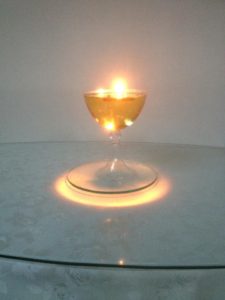
“He is grace-giving grace, not because he possesses it, but because he gives the immeasurable, incomprehensible light.”
Secret Book of John, Nag Hammadi Library, translated by Frederik Wisse
Two villages near Lordat are named Luzenac (luz meaning light) and Lassur (Lassare is French for Lazarus) or ‘light of Lazarus’? And a hill next to the nearby chateau of Montreal-de-Sos, is called Col de Grail. Biblical and Gnostic texts tell us of the house at Bethany near Jerusalem, where Jesus often visited the family of Mary Magdalene, Martha and John-Lazarus. In the depictions of John and Magdalene across Europe and beyond, they are the ones shown holding a cup, vase or grail vessel, guardians of a secret tradition.
 Lestelle-Betharram—Star of the High House
Lestelle-Betharram—Star of the High House
“Glance at the sun. See the moon and the stars…
All nature is at the disposal of humankind.
We are to work with it.
For without it we cannot survive.”
Hildegarde von Bingen
On the river Gave de Pau, nestled in the rugged Pyrenees of France, there is a village called Lestelle-Betharram. Although it is only fifteen kilometers from the famous pilgrims’ destination of Lourdes, it is not as well-known. However, during the 17th and 18th centuries it was one of the most popular pilgrimage sites in Europe. During the medieval era, pilgrims would stop at this ancient sanctuary as a station on the Camino de Compostella and knights returning from their campaigns against the Moors in Spain would rest here to pay homage to Our Lady. The name of the village is intriguing, Lestelle, or l’estelle, meaning the star in the old French, from the Latin stella; beth means house in Hebrew; arram is a Hebrew word meaning high or elevated, hence Star of the High House.
The local church of Our Lady of Betharram was built to honor her numerous miraculous appearances over the centuries and is overlooking the river where she appeared. Entering the church one is greeted by a large painting of Mary Magdalene anointing the feet of Jesus with her vase of spikenard. Both Jesus and a male disciple are pointing at her as ‘The One who knew the all’. The painting shows Magdalene as one who truly understood the inner mysteries:
“Mariham, Mariham, the beloved…speak in boldness, because thou art she whose heart stretches toward the Kingdom of the heavens… you who will give light upon everything in accuracy and in exactness.”
Pistis Sophia Codex
 Could Lestelle-Betharram also hint at Magdalene and John, The Stars of Bethany? As mentioned earlier, the home of Mary Magdalene and her brother John-Lazarus was in Bethany, and both are traditionally portrayed with grail vessels — John with a cup, often with a snake, and Mary with her jar or vase of unguents for the Messianic anointing ritual. The cup is the container which holds the light of initiation and it appears that they were at the center of those who were guardians of the secrets of ascension and resurrection.
Could Lestelle-Betharram also hint at Magdalene and John, The Stars of Bethany? As mentioned earlier, the home of Mary Magdalene and her brother John-Lazarus was in Bethany, and both are traditionally portrayed with grail vessels — John with a cup, often with a snake, and Mary with her jar or vase of unguents for the Messianic anointing ritual. The cup is the container which holds the light of initiation and it appears that they were at the center of those who were guardians of the secrets of ascension and resurrection.
Opposite and facing this painting of the anointing of Jesus by Magdalene, is a large painted sculpture of Saint John holding a cup with a snake coiled around the rim. (Although the Catholic Church claimed the image depicted expelling the poison of the serpent.) John is standing on the eagle, the other symbol normally associated with him. The assumed authors of the other three synoptic gospels of Matthew, Mark and Luke are represented by the human, the lion and the bull respectively, which signify the four fixed signs of the zodiac and the ages of Aquarius (Matthew), Leo (Mark), and Taurus (Luke) and Scorpio (John).
John’s is the gospel that stands out as unique among them all and begins with the words: In 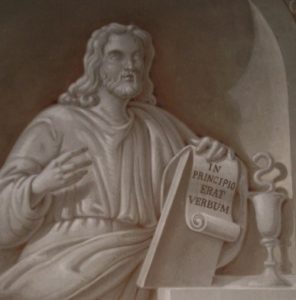 Principio Erat Verbum, ‘In the Beginning was the Word’, indicating a knowledge of sound science and the creative power of resonance. The serpent grail held by John is an alchemical symbol of wisdom and the Hermetic science of ascension. As Jesus said in John’s Gospel, “I am the resurrection and the life..”
Principio Erat Verbum, ‘In the Beginning was the Word’, indicating a knowledge of sound science and the creative power of resonance. The serpent grail held by John is an alchemical symbol of wisdom and the Hermetic science of ascension. As Jesus said in John’s Gospel, “I am the resurrection and the life..”
John-Lazarus was the one who received the resurrection mysteries teaching from Yeshua as recorded in the ‘Secret Gospel of Mark’ written my Morton Smith. The Secret Gospel is based on little-known documents that Smith discovered in the library of St. Catherine of Alexandria Monastery in the Sinai. John’s symbols of the eagle and the serpent represent the wisdom of heaven and earth, the Hermetic maxim– As Above, So Below.
John’s Grail and the Serpent of Resurrection

“The grail you speak of is a symbol and it stands for the doctrine which Christ taught to John the Beloved alone. We have it still.”
‘The Treasure of Montsegur’,Walter Birks and R. A. Gilbert.
As I had mentioned in Part 2 of the current article, the Cathars preferred studying the Gospel of John. For Walter Birks, the information regarding the Nosairi sect and John’s Grail connected the puzzle pieces of his years of travels and research of Catharism with the first Christians. It seems likely that the Nosairi tradition of Syria must have been related to the early Christian Nazoreans or Nassenes, a 1st century Gnostic group, said to honor the ancient serpent wisdom. Having also traveled the world over several decades as a troubadour, I had noticed that many cultures used a similar linguistic root in the syllable NA and its meaning of serpent, wisdom or ‘godliness’.
The  Hebrew word for snake is na’asch; Sanskrit Nagas are serpent-dragon wisdom deities; Nadi in Sanskrit is the energy movement and serpent path of the human chakra system; in Mayan, Na Chan means House of the Serpent, the old name for
Hebrew word for snake is na’asch; Sanskrit Nagas are serpent-dragon wisdom deities; Nadi in Sanskrit is the energy movement and serpent path of the human chakra system; in Mayan, Na Chan means House of the Serpent, the old name for 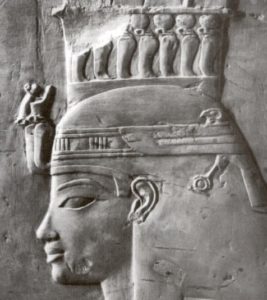 the pyramid-temple city of Palenque; in Yaqui language (a meso-American tribe), Nagual is the term for shaman, wisdom keeper; Nana or Inanna is the ancient Sumerian Wisdom Mother Goddess; the Egyptian hieroglyph for the NN sound is a wave form shaped like a serpent (even though it signifies water); the Koran lists Naz’ra as the Arabic name for early Christians; a Gnostic sect during the time of Jesus were called Naassenes who honored Sophia, the Mother of the World, whose name means wisdom; and in John’s Gospel, when the temple police in Jerusalem were looking for Jesus, they demanded, “Where is the Nazorean”
the pyramid-temple city of Palenque; in Yaqui language (a meso-American tribe), Nagual is the term for shaman, wisdom keeper; Nana or Inanna is the ancient Sumerian Wisdom Mother Goddess; the Egyptian hieroglyph for the NN sound is a wave form shaped like a serpent (even though it signifies water); the Koran lists Naz’ra as the Arabic name for early Christians; a Gnostic sect during the time of Jesus were called Naassenes who honored Sophia, the Mother of the World, whose name means wisdom; and in John’s Gospel, when the temple police in Jerusalem were looking for Jesus, they demanded, “Where is the Nazorean”

“And as Moses lifted up the serpent in the wilderness, even so must the Son of man be lifted up.” John 3:14
When seen from a visionary perspective, a matrix of related patterns emerges, and a story woven through time begins to reveal itself. The original knowledge carried on by Jesus’ inner circle taught the mysteries of wisdom, love and healing. The serpent shape in the Chalice of John is also a glyph depicted in numerous Native American rock art and petroglyphs as an undulating line. It can symbolize snake wisdom, energy movement, or water. The serpent movement is also in the awakening nadi meridians in the human body, the Kundalini yoga of inner resurrection–it is the movement of sound waves, and the symbol for the sign for the Age of Aquarius.
Some of the basic practices used to purify the body, mind and spirit were common to all these ‘Serpent Wisdom’ cultures–various forms of meditation, chant, sacred music, yoga or other specific movements, breathing exercises, fasting and sun gazing. It is the path of healing and awakening that arose at the time of Jesus, which resurfaced during the medieval era with the Cathar movement and is returning again in our current era. As Jesus said in the gospel of Matthew, “You are the Salt of the Earth, the Light of the World.”
 These ancient cultures were the true guardians of the Grail and the inner mystery traditions–Guardians of the knowledge needed today to lift awakening humanity from the dark cave of unconsciousness to their divine light essence. The Tibetans call this inner reality of every being ‘Ground Luminosity’. This is not to deny the sometimes dark and dense journey through matter, but embracing and integrating the gifts of life’s lessons and navigating one’s way through consciously as a seed makes its way through dark soil toward the sun.
These ancient cultures were the true guardians of the Grail and the inner mystery traditions–Guardians of the knowledge needed today to lift awakening humanity from the dark cave of unconsciousness to their divine light essence. The Tibetans call this inner reality of every being ‘Ground Luminosity’. This is not to deny the sometimes dark and dense journey through matter, but embracing and integrating the gifts of life’s lessons and navigating one’s way through consciously as a seed makes its way through dark soil toward the sun.
“Deliver us from these human forms and re-clothe us in light among the stars.”
Syrian Nosairi prayer, ‘The Treasure of Montsegur’ by Walter Birks and R. A. Gilbert.
This is the Cathar Way, the path to perfection, the journey of purification and the Cathar Perfect’s con-sol-amentum, (literally translated ‘with the sun in the mind’. This the path of the Egyptian initiate depicted by the cobra, Ureaus of awakening at the third eye, signifying mastery of the serpent 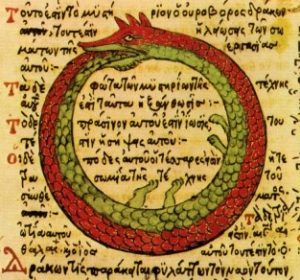 movement within the body, mind and spirit. This is the illumination of Re-Herakhty, Horus of the Solar Horizon, as it appears at the brow of the adept in the dawning of wisdom.
movement within the body, mind and spirit. This is the illumination of Re-Herakhty, Horus of the Solar Horizon, as it appears at the brow of the adept in the dawning of wisdom.
This is the truth of Thoth and Ma’at, who taught that by continual singing of harmonious chants, humans grew like unto the Gods. This is the Great Work of alchemy symbolized by the unity of the Ouroboros snake eating its own tail. It is the above and the below, the return and becoming One of Thoth-Hermes. This is the wisdom path of Sophia.
Now is the time of Revelation as written in John’s message, the time of great awakening–the return of the path of the heart and the wisdom that liberates. This is the time to remember our original intention and the time for the re-enchantment of our world.
“Postscript, a postcard from Paradise:
Dear Children,
Wish you were here.
Here we are all one.
Signed–Tree, Adam, Eve, and Snake”.
Medhananda ‘Archetypes of Liberation’
All writing and images © Ani Williams 2012, Rennes-les-Bains, France
For additional reading on Mary Magdalene see additional articles on this website:
https://aniwilliams.com/mary-magdalene-mistress-of-the-grail/
This article in addition to Parts 1 and 2 on this website, were originally published in the book ‘The Cathar View—The Mysterious Legacy of Montsegur’ available on Amazon.
Photo Credits:
- Troubadours from Troubadours & trouvères by René Nelli, published by Hachette 1979
- Harp at Chateau Puivert, photo Ani Williams
- Ani at Tour Magdala, Rennes-le-Chateau, photo Stephen M. Marcus
- Pentagon—Cathar Cross, Gadal Museum, Ussat les Bains, photo Ani Williams
- Grail of light, photo Ani Williams
- Montreal de Sos, photo Ani Williams
- Cathar memorial, Minervois. Photo Ani Williams
- Montreal de Sos cave painting from Lectorium Rosicrucianum
- Ussat Grotto, photo AW
- Pentagram in Rennes-le-Chateau, ‘Key to the Sacred Pattern’ by Henry Lincoln. Used with permission.
- Montsegur. Photo AZ
- Henry Lincoln with Deodat Roche Museum, Arques. Photo AW
- Arques Chateau. Photo AW
- Stone Stelle, Deodat Roche Museum, Arques. Photo AW
- Magdalene arrives in Provence. Chapel of Saint Baume, photo AW
- Lestelle-Betharram Chapel, Santiago de Compostella window, photo AW
- Lestelle-Betharram Chapel, Mary Magdalene Anointing painting, photo AW
- Lestelle-Betharram Chapel, John with Snake and Eagle, photo AZ
- St. John with Cup and Green Snake, St. Catherine’s Church, Westford, Mass., photo AW
- St. John with Cup, Snake and Gospel, St. Lassare Church, Avallon, France, photo AW
- Descent of the Dove, Holy Spirit, Lourdes Cathedral, photo AW
- Foix Chateau, photo AW
- Alchemical symbol oroborous, beginning and end from De Rolla
- Adam, Eve, Tree and Snake, St. Nazaire Church, Carcassonne, photo AW
